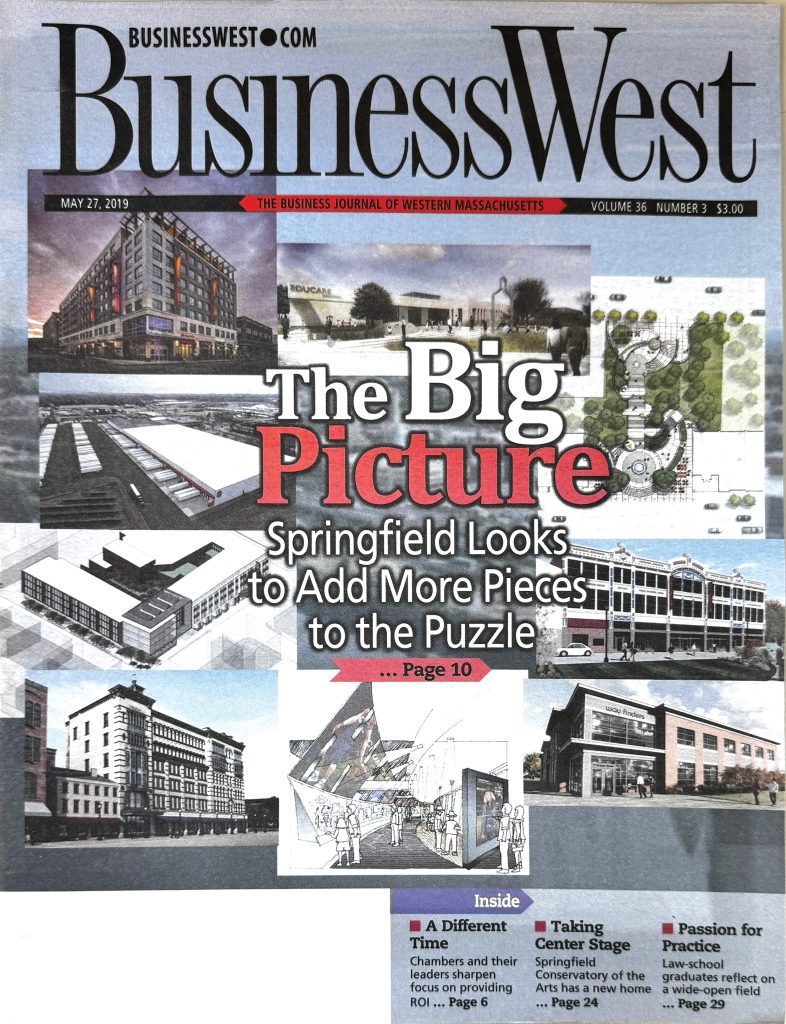
40 Years of Commercial Development
The Landscape Has Changed — in Many Ways
 When Jack Dill, president of Colebrook Realty Services, arrived in downtown Springfield in the mid-’70s, it was a different world and a much different city.
When Jack Dill, president of Colebrook Realty Services, arrived in downtown Springfield in the mid-’70s, it was a different world and a much different city.
The still-new mixed-use complex on Main Street, then called Baystate West, complete with a 28-story office tower, was crammed with retail on two floors (much of it migrating from storefronts elsewhere in the downtown), everything from a Friendly’s to a sporting-goods store to a men’s clothing shop.
It was connected via airwalks to two major department stores, Forbes & Wallace and Steiger’s, the latter of which was also connected via airwalk to an even more recent addition to the landscape, the new home of Springfield Institution for Savings, which Dill helped conceptualize and build as an employee of the bank. It, too, had retail and restaurants on two floors.
By 1984, the scene had started to change, with retail experiencing a sharp decline in Baystate West with the opening of the Holyoke Mall in 1979. Forbes & Wallace was soon demolished to make way for what is still known as Monarch Place, even though the namesake tenant and partner in the project, Monarch Capital Corp., filed for bankruptcy in 1991, and the property was subsequently sold at auction to Peter Picknelly.
By the mid-’90s, Steiger’s was demolished as well. In its place was built a park dubbed “a little park for a little while.” It’s still there. Meanwhile, at what is now Tower Square, there is very little retail (although Big Y is now a tenant), but two colleges (UMass Amherst and Cambridge College) and the YMCA of Greater Springfield call it home. And at what is now the TD Building, which Dill now co-owns, there is just a single restaurant, but the Springfield Symphony Orchestra, United Way of Pioneer Valley, and the Western Massachusetts Economic Development Council and its many affiliates are based there.
This quick history lesson helps show the many ways the landscape has changed over 40 years and continues to change, said Dill, adding that downtown Springfield is not unlike many other downtowns that suffered losses in retail to the malls and, later, internet shopping, and other properties — from the offices of banks that no longer exist to long-closed mills, to most of the Springfield Republican building — given over to new uses ranging from housing to breweries; from cannabis dispensaries to co-working facilities.
And we haven’t even mentioned the new, $1 billion casino complex built a few blocks south on Main Street.
“And now, the internet and that kind of distribution model is creating real problems for the large, enclosed malls,” said Dill, citing the ongoing demolition of the Eastfield Mall, the first such facility in the region, and the start of work to transform it into a mix of retail, housing, and other uses, as an example of how the scene continues to shift and change the landscape in the process.
Jack Dill
“The internet and that kind of distribution model is creating real problems for the large, enclosed malls.”
Evan Plotkin, president of Springfield-based NAI Plotkin, agreed. He said the landscape has certainly changed from a commercial real-estate perspective, and it continues to evolve due to powerful forces ranging from malls to consolidation of the financial-services sector to, most recently, the COVID 19 pandemic, which introduced the world to remote work and hybrid schedules that left many to ponder the fate of office facilities in communities of all sizes.
He has seen, and been part of, movements to create dedicated facilities for healthcare practices (something that was novel four decades ago when such businesses would be next to accountants and lawyers) and to rethink downtown office towers, such as the one he owns, 1350 Main St. in Springfield.
Plotkin said the rise of remote work will certainly impact demand for office space, but he sees a partially offsetting force in east-west rail, which has the potential to put some area communities on the map, drive development in areas near the rail stops, and even prompt some businesses to realize they don’t have to be in Boston anymore.
“It could be transformative; in Springfield, for example, it could drive development in the Union Station area and make that area much more attractive,” he said, adding that he’s already seen more interest in properties there. “If east-west rail is successful, and I think it will be, and it becomes a reliable way to get to Worcester or Boston, it changes things dramatically.”
Space Exploration
Overall, the real-estate sector has seen a number of ups and downs over the past 40 years, from the boom times of the mid-’80s to the bust that came later that decade; from the surge provided by the arrival of the cannabis industry — which impacted most communities, but especially Holyoke — to the most recent turmoil resulting from the pandemic. And there have been headwinds of different strengths, from the tornado in 2011 to the Great Recession of 2008 to Springfield’s being placed in receivership 20 years ago.
Evan Plotkin
“If east-west rail is successful, and I think it will be, and it becomes a reliable way to get to Worcester or Boston, it changes things dramatically.”
Overall, compared to other regions, the scene in Springfield and surrounding communities has remained relatively flat, said those we spoke with. There has been some new building and notable renovation projects — Springfield’s Union Station tops that list — but, overall, little movement of new businesses into the region (MGM Springfield being a major exception) and large amounts of what Plotkin called “musical chairs,” tenants moving from one location in the region to another.
“I’m seeing a lot of businesses move from property to property, but not really much new growth,” he explained. “We really need to look at how we can bring new businesses here.”
Meanwhile, the landscape has certainly changed on the retail side — everything from the departure of Johnson’s Bookstore, a watershed moment in the history of downtown Springfield, to the ongoing redevelopment of the site of the massive GE transformer complex in Pittsfield; from the successful conclusion of decades-long efforts to convert the former Court Square Hotel in downtown Springfield into a mix of retail and market-rate housing (the first tenants have started moving in) to the massive, ongoing effort to redevelop the massive Ludlow Mills property. That undertaking, a mix of brownfield and greenfield development led by Westmass Area Development Corp., is already more than a decade along, and will likely take another decade.
At present, with interest rates high and questions about the economy (let alone who will occupy the White House) moving forward, new building has been mostly stagnant, said those we spoke with, creating a white-hot market for manufacturing and distribution facilities. Meanwhile, cannabis is starting to retreat, with some of the properties turned over to that use (or intended for that use) now back on the market, especially in Holyoke.
But the biggest area of concern moving forward is the office market. Remote work and its impact on how much space companies will need is a huge factor, but there are other considerations as well, said Plotkin and Dill, noting that the continued consolidation of many sectors (a thread running through these 40th-anniversary stories) is an issue as well.
And it has been for decades now.
“Coopers & Lybrand had a large presence here, and they consolidated and moved to Hartford,” said Dill, citing just one example of this movement from years ago. “There are fewer banks, fewer head offices … fewer players in many sectors, and it has certainly impacted the market.”
“Having access to Boston that’s walkable from your downtown … that will have a big impact. You can live in downtown Springfield and, in an hour and a half, be in Boston. It takes longer than that to drive to Boston from Sudbury.”
As for remote work, Dill preferred to remain somewhat optimistic about its future and, thus, its overall impact on the real-estate market, despite growing concern, if not outright panic, in larger cities such as Boston and San Francisco.
“It’s taken some time, but we’re starting to see a return to the office,” he said, noting that several major corporations are ordering workers back, or trying to. “Work is kind of a social activity — there’s a reason we were all together in the first place as opposed to being out tending our own field.
“The joys of working at home, working in your pajamas, gets old after a while, I think,” he went on, leaving room for a measure of compromise in the form of a four-day workweek.
Plotkin is not quite as optimistic. He sees more permanence to remote work and hybrid schedules, and noted that Zoom has greatly reduced the need for people to be in their offices and for consumers to visit these offices.
This leaves questions about existing office towers and other facilities and their futures, he said, adding that conversion to residential use is an option that should be explored.
There is a huge need for housing in the region, he went on, and the need may grow if east-west rail becomes a reality, which he believes it will.
“Having access to Boston that’s walkable from your downtown … that will have a big impact,” Plotkin said. “You can live in downtown Springfield and, in an hour and a half, be in Boston. It takes longer than that to drive to Boston from Sudbury.”
Bottom Line
Flashing back 40 years, Dill said that, in many respects, downtown Springfield still looks a lot like it did then, at least from the street.
But a closer look — one inside the buildings on either side of Main Street — reveals large amounts of change, especially in Tower Square and the TD Bank building.
It’s very difficult to project what might come next given all that has happened over the past four decades, from the rise of malls to the demise of many of them, said Dill, adding quickly, and forcefully, that the only constant is change.






